Caraquet, New Brunswick 作者: 来源: 发布时间:2021-12-02
I.Population and Area
-Area
Land: 68.35 km2 (26.39 sq mi)
-Population (2016)
Total: 4,248
Density: 62.1/km2 (161/sq mi)
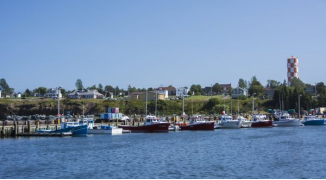
II.Natural Geography (environment and resources)
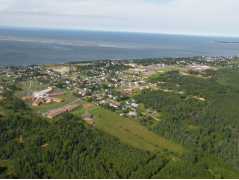
-Caraquet is a town in Gloucester County, New Brunswick, Canada.
-Situated on the shore of Chaleur Bay in the Acadian Peninsula, its name is derived from the Mi'kmaq term for meeting of two rivers. The Caraquet River and Rivière du Nord flow into the Caraquet Bay west of the town.
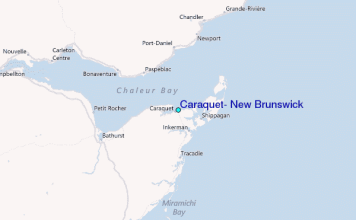
-Caraquet, town and fishing port, Gloucester county, northeastern New Brunswick, Canada. It lies along Caraquet Bay (an inlet of Chaleur Bay), near the mouth of the Caraquet River, 42 miles (68 km) northeast of Bathurst. Founded about 1760 by shipwrecked French seamen, it is one of the province’s oldest French settlements and was named for the bay, which may have derived its name from a French nautical term, caraque, meaning “carrack,” or “large galleon.” After 1784 the town became strongly French Acadian. It is now the home port for a large Atlantic fishing fleet and has a fisheries school, boatbuilding facilities, and fish-, crab-, and oyster-packing plants. Historical associations are reflected by its Acadian Museum and the nearby reconstructed Acadian Historical Village. The blessing of the fleet by the bishop of Bathurst is a notable annual (July) event. Inc. 1961. Pop. (2006) 4,156; (2011) 4,169.
III.ECONOMY
-Average Hourly Rate in Caraquet, New Brunswick: C$17.75
-Website: https://www.payscale.com/research/CA/Location=Caraquet-New-Brunswick/Salary
-The average salary in Caraquet, New Brunswick is C$17.75. Trends in wages decreased by -100.0 percent in Q1 2020. The cost of living in Caraquet, New Brunswick is 100 percent higher than the national average. The most popular occupation in Caraquet, New Brunswick is Mechanical Engineering Technologist which pays between C$11.53 and C$79.46 per year.
IV.Industrial Characteristics
-Caraquet's economy is primarily marine resource-based, with a fishing wharf and seaport. Several beaches and other tourist attractions, such as the Village Historique Acadien, are located in the area. New Brunswick's only francophone daily newspaper, L'Acadie Nouvelle, is published in Caraquet.
-Agriculture and Aquaculture The food production and processing industries of New Brunswick are important components of the provincial economy, supporting the employment of 17,000 people, mostly in rural communities. Combined food and beverage shipments were valued at $2 billion in 2005.
V.Attractions
1.The Village historique acadien

-Village historique acadien is an historical reconstruction that portrays the way of life of Acadians between 1770 and 1949. It is located in Bertrand, in northeastern New Brunswick, 50 kilometres (31 mi) east of Bathurst and 130 kilometres (81 mi) north of Miramichi, New Brunswick.
-More than 40 buildings are staffed by interpreters in period costume who bring ancestral customs and traditional trades to life. Among the attractions is Hôtel Château Albert, a replica of a turn-of the century hotel that once existed in Caraquet. The original was destroyed by fire in 1955 but it has been re-created at the Village. It offers overnight accommodations as well as a dining room.
-Allow a minimum of 3 hours for a complete visit.
-The Village historique acadien is a tourism complex built around a 2.2 km circuit bordered with historical buildings, all inhabited by fully bilingual (French and English) interpretive guides.
-More than a simple open-air museum, the historical site houses a vast array of characters that come to life by portraying the day-to-day lives and major events of Acadian families from 1770 to 1949, showcasing their customs, their creativity and, most of all, their wholehearted hospitality.
-From June to October, visitors are therefore invited to take in the breathtaking scenery as they enjoy a wide variety of daily experiences: so go ahead and join the children’s day camp, spend the night at the Château Albert Hotel, sign up for a traditional Acadian cooking workshop, or just lie back and enjoy our many restaurants and cultural activities!
-Address: 5 Rue Du Pont, Bertrand, NB E1W 0E1
-Phone: (506) 726-2600
-Website: https://villagehistoriqueacadien.com/en/site
2.Sanctuaire catholique Sainte-Anne-du-Bocage
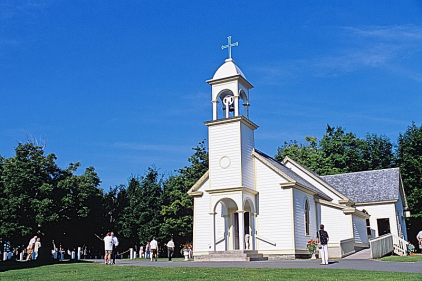
-DESCRIPTION OF HISTORIC PLACE
Sainte-Anne Chapel is a one-storey wooden religious building with a central three-storey bell tower on the front façade. This vernacular Gothic Revival chapel is located on the north side of St-Pierre-Ouest Boulevard, in a grove overlooking Caraquet Bay.
-HERITAGE VALUE
Sainte-Anne Chapel is designated a Local Historic Place for its religious importance in the community and for its architecture.
Sainte-Anne Chapel is recognized for its religious importance in Caraquet. It was built on the site of the first church in Caraquet and has been an important pilgrimage site dedicated to St. Anne for more than a century and a half.
The Sainte-Anne Chapel is also recognized for its architecture. Built around 1840, its interior has undergone little modification, while its exterior has seen renovations and additions. It remains a good example of vernacular Gothic Revival religious architecture from this era in Caraquet.
Source: Caraquet Town Hall, Historic Places files, “Chapelle Sainte-Anne”
-CHARACTER-DEFINING ELEMENTS
The character-defining elements that describe the architecture of Sainte-Anne Chapel include: - one-storey rectangular massing; - symmetrical front façade with three-storey central bell tower and cupola; - Gothic Revival windows.
The character-defining elements that describe the interior of Sainte-Anne Chapel include: - interior pine trim; - vaulted ceiling; - wrought-iron door handle and latch; - pine floor with pegs; - holy water font at entrance sculpted in block of wood; - altar with statue of St. Anne.
Address: W. St. Peter Blvd. &, Rue Sainte Anne N, Caraquet, NB E1W 1A2
-Opened: 1836
-Phone: (506) 727-3212
-Website: https://www.historicplaces.ca/en/rep-reg/place-lieu.aspx?id=8014
3.Musée acadien de Caraquet
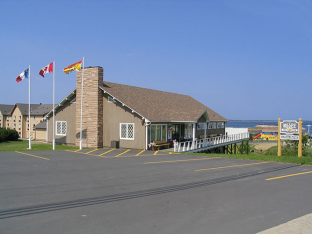
-Le Musée acadien de Caraquet retrace l’histoire et la culture de la Péninsule acadienne depuis l’arrivée des premiers habitants jusqu’à aujourd’hui. Les expositions montées à partir de sa riche collection et d’archives régionales nous ramènent dans le temps de nos ancêtres.
-Address: 15, boulevard St-Pierre Est, Caraquet, N.-B.
-TEL: 506.726.2682
-Website: http://rmne.ca/musee-acadien-de-caraquet
VI.History
-The Mi'kmaq were the first to have visited the region, as early as 4000 years ago. Objects have been discovered in the port but it is thought they used the place as a camp and not as a village. The Vikings had visited the region from the year one thousand, then we know that Basque, Breton and Norman fishermen came in the thirteenth century. Jacques Cartier explored the surrounding area in 1534. In 1713, Great Britain obtained Acadia in the Treaty of Utrecht. Caraquet was founded around 1731 by the Breton Gabriel Giraud dit Saint-Jean. It stood on the present site of the border with Bas-Caraquet.
-In 1755, the British took Fort Beauséjour and began the deportation of the Acadians. A group of survivors led by Alexis Landry took refuge in Caraquet in 1757 at a place called Sainte-Anne-du-Bocage. Several privateers, Captain Saint-Simon and survivors of the Battle of the Restigouche took refuge in the village of Gabriel Giraud in 1760. The following year, Pierre du Calvet made a census of the Chaleur Bay, whose purpose was to determine where and how many Acadians were hiding there. In retaliation for the Battle, Roderick MacKenzie captured most of the refugees, including 20 people of the 174 then in Caraquet. The rest of the population emigrated to other places in the Bay of Chaleur, especially Miscou and Bonaventure.
-In 1763, Great Britain finally dispossessed Louis XV of North America in the Treaty of Paris. George III's Royal Proclamation of 1763 and administrative changes the next year then allowed Acadians on land not occupied by the British. Most families returned to Caraquet from 1766. Bourdages Raymond founded a fishing station in 1762 but it was the target of attacks by American privateers in 1776 and by Micmac in 1779. In 1784, François Gionet walked to Halifax where the Great Grant was obtained, legalizing the occupation of Caraquet by 34 families of 57 km². Families of Norman fishermen had meanwhile established themselves in town and were followed by French Canadians.
-Merchants from England, Scotland and Jersey settled in Caraquet from the early nineteenth century. Despite their small number, they would control the economy and politics of the city for a century. Charles Robin and Company opened an important fishery in 1837, followed by that of Robert Young in 1850. The government of George King voted in the Common Schools Act in 1871 which removed any religious presence in schools and made education difficult in French. The precarious economic situation of fishermen, the discontent caused by the Common Schools Act and the attempts of the Anglophones to control the board led to Acadian protests in January 1875. Following property damage from the protests, Robert Young ordered police to the city and supplemented them with a private militia. When militiamen attempted to force entry to an Acadian household on January 27, 1875, an exchange of gunfire resulted and militiaman John Gifford and Acadian Louis Mailloux were shot and killed. Calm was restored and the population got some concessions.
-Despite the Industrial Revolution, Canadian Confederation hurt the Maritime Provinces. To counter the exodus of the population and control of fishing companies, new farming villages were founded. In 1864, the engineer Sanford Fleming proposed to build the Intercolonial Railway from Montreal to Pokesudie through Caraquet. While the final route was diverted south to Halifax in 1868, the line was built to Caraquet in 1887 following a part of the originally proposed route. The opening of the railway increased economic development with the opening of shops and hotels as well as a change of habits. The College Sacre Coeur opened its doors in 1899 but was destroyed by fire in 1914; it moved to Bathurst the next year. The Fifth National Acadian Convention was held in 1905.
VII.Other information
-Culture
Named Cultural Capital of Canada in 2003 and 2009, the town of Caraquet cherish a traditional culture that has adapted by reaching out to new generations. This culture is enlightening and innovative, it's an artistic mix that cradles the stories of yesterday and creates the memories of tomorrow. The importance of its historic heritage and the impressive number of arts and culture organizations and events operating in the region make Caraquet a must-see destination for all those who want to bathe and be carried away by Acadian culture. Over the years, the Town of Caraquet has developed major cultural infrastructures such as the Centre culturel, which houses the Galerie Bernard-Jean and a theater, the Carrefour de la Mer and the movie theatre. In the town of Caraquet, there are about thirty cultural organizations, as well as all other sectors of activity, that can benefit from it.
-Infrastructure
-Artistic and Cultural Sector
If the town of Caraquet is the cradle of culture by being the springboard for emerging artists and the fertile ground of professional artists, it is thanks to the infrastructure it has built over the years. The Carrefour de la mer is a recreational and tourist establishment that has an indoor theater and an outdoor stage. Every year, for more than 22 years, the Festival des arts visuels en Atlantique, as well as several Festival acadien shows, are produced there. The place continues to be enhanced with shops, a café, a terrace bar, restaurants, an outdoor playground for children, a walking path to the sea and superb amenities for pleasure boaters. Just behind the Carrefour is now a walkway named Le Quai des artistes that has six small shacks on stilt where artists exhibit during the summer period. It is truly a must for anyone visiting Caraquet. Just a step from the Carrefour is the Quai de Caraquet and its restaurants that will serve you the best seafood in town!
For book launches, press conferences, banquets, and shows, the Centre culturel is also a special place where diversity and creativity reign, and where are located various organizations. Also in the Centre culturel is the Galerie Bernard-Jean that welcomes professional artists and artists who finish artistic residencies in the region to present their works.
Right next to the Centre culturel is the Cinema du centre which has a rich programming and who really promotes French culture. In parallel with large-scale films, Ciné+ presents films from various cultures and French-speaking regions around the world. With a friendly staff, screenings for all ages and tastes, and that aim to educate, raise awareness, and promote culture, Cinema du centre is a very busy and constantly innovating place.
-Sports and Recreation Sector
The City of Caraquet has a full range of sports and recreational facilities. The arena is located in the heart of the city and just behind is the athletics track that hosted the Jeux de l'Acadie in 2016. In addition to an indoor pool and a gym that offers courses and training programs, the city has a treasure in the heart of the forest for those who enjoy outdoor sports. With its ski and snowshoe trails, skating rinks, four-season cycling and hiking trails as well as its family calendar, the Club plein air is worth the trip by offering the opportunity to nature to be seen under its most beautiful angles.
Throughout the city is a 90 km bike path, where you can have scenic views of the sea and from where you will also see the village of Maisonnette and wooded areas. In the winter, some sections of the trail are part of the snowmobile trails. Whether you play golf, tennis, soccer, basketball, handball, bowling, bingo or pool, you'll be able to practice your activities. For those who want to improve in the martial arts or horseback riding, this is also a possibility that is available to you.
Several organizations work to support various sports such as hockey, figure skating, speed skating, cross-country skiing, snowmobiling, scuba diving, tennis, hunting, and fishing.
-Website: https://caraquet.ca/en/culture#infrastructures
VIII.Contact information
-Government
Type: Town Council
Mayor: Kevin Haché
-Town Hall
P.O. Box 5695
10 du Colisée Street
Caraquet NB E1W 1B7
-Email : ville@caraquet.ca
-Phone : (506) 726-2727
-Fax : (506) 726-2660
-Website: https://caraquet.ca/en/culture#infrastructures
